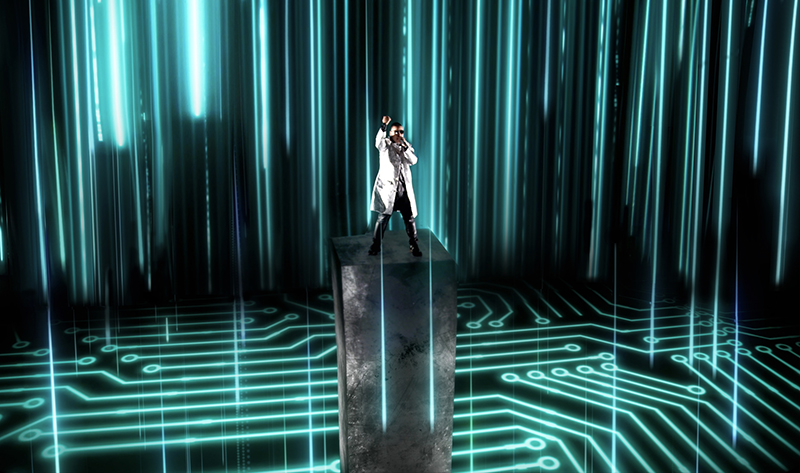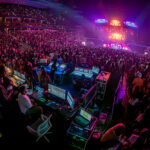
darmah’s Production Design & Creative Approach Offers Another Option to Live Award Shows
The Billboard Latin Music Awards on Oct. 21 generated 45.9 million engagements across Telemundo-owned platforms, plus 38 million engagements across other platforms, ranking it as the number-one Spanish-language special in primetime since the pandemic struck. The producers have no doubt to the reason for the success: they were able to create a mostly live show that included a live audience. Mary Black Suarez of MBS Special Events produced the awards for Telemundo and told Billboard magazine that it was like producing two shows at once: “The Covid show and the Billboard Latin Music show,” she said. “I have never seen a show done like this. Then again, we have never had Covid before.”
darmah was responsible for the production design and the creative direction of the musical performances. The show featured 18 performances including the Black Eyed Peas, Pitbull, Maluma, Carlos Vives, Daddy Yankee, Ozuna, and Anuel AA — most of them live. “The desire for as much of a live show as possible required a design that allowed for all the pandemic safety protections and protocols necessary, and yet have all the excitement of live award show with a real audience,” says Rodrigo Proal, darmah founder. “We had to maximize the entertainment value but minimize everything else, from the number of crew to how the acts performed.” This year’s set design allowed sets to be UV sanitized between acts and facilitated social distancing.
darmah was also a vendor for the show, providing all of the advanced cutting-edge video gear for the set. As is darmah’s preference, their brand of choice for all the LED screens is ROE Visual. All total, it added up to almost seven million pixels of the best state-of-the-art technology that could be displayed. As part of their creative workflow, the media servers and playback system of choice was disguise — as it always is. The main stage setup included disguise VX4 and 4×4 Pro hardware. Two of the performances were filmed back at their Miami studio on their revolutionary dXR stage, which relies on B02 and BM4 ROE LED screens and disguise’s RXs and VX4 servers to create multidimensional XR sets. Brompton Tessera M2 LED processors were used in both locations.

The Logistics
The Latin music industry’s longest running award show was originally scheduled for April before being postponed to Oct. 21 in BB&T Center in Fort Lauderdale. “We had to redesign the previous set with considerations of Covid protection,” explains Rodrigo Proal. The new proposal was a 360-degree octagon-shaped seven-stage set. Two of the stages were where the award presenters and the winners went; one was for the show host; and four stages were for the live performances. But even those four stages were divided — two were used for acts with dancers, and two were used with acts with musicians. “The four performance stages were color-coded, and each had its own small crew,” Proal adds.
The dancers and production crew members quarantined in a hotel per the CDC recommended period before the show. All performers and crew members had to be tested daily, and no one was allowed in the arena who didn’t absolutely have to be there. Artists could only bring in four of their team for rehearsal and show day. Audience members were contained to the minimum of 120 spaces. Masks where mandatory for everyone, though singers took them off for their performances. As for the dancers, their masks were made part of the costume.
“We were able to have stages that didn’t need 200 people around it to create a performance and deliver a live show where you limited the risk of Covid,” says darmah partner Bianca Moncada. The stages were designed smaller thus making the stars look bigger, and they also created the overall space so there was no need for large scenic props and was void of large empty areas. John Daniels , lighting designer, also joined the challenge of recreating the glamor and excitement of replicating pre-pandemic levels of audience participation — even with a much smaller audience.
darmah’s creative team sat down with Mary Black Suarez and came up with a proposal for each act based on the song they were doing with the Artist’s input. Despite the segregated stages, they were able to pull off the highlights of these type of award shows: duets. Ozuna performed “with” the Black Eyed Peas, but while they were on separate stages, the camera work and video design gave the in-house and at-home audience the look and feel of a true spontaneous collaboration. Pablo Alborán, Luis Fonsi, Jesús Navarro and Joy sang a medley of Mexican singer-songwriter Armando Manzanero’s classic songs that allowed them to interact as if they were all on the same stage. It was an exciting and moving tribute for Manzanero’s induction into the Billboard Latin Music Hall of Fame.
Particularly eye-popping was that Daddy Yankee and Ozuna started their performance in an immersive virtual world created in darmah’s dXR stage, which features the latest Extended Reality (XR) technology. The segment began there, but then seamlessly transitioned to performing the song live about a third of the way through on the main stage at the BB&T Center. “The producers wanted to bring our technology to the show in a different way, and we were all pleased with the results,” says Moncada. She adds that it was accomplished by great team effort from lighting, video, cameras, choreography, and wardrobe.
But everything was dictated by safety. “Everyone needed to follow so many rules to make this production possible, and they did,” Proal says. “It was wonderful to feel the rush of a live show, but also knowing that everyone prepared for safety. To be part of something that has set the standard for what is possible for a live television event in these pandemic times makes us very proud.”


